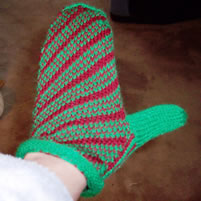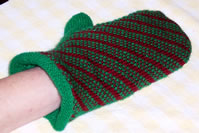
Hand Knit Mittens
Seamless mittens, knit on double pointed needles.
This page has a pattern generator (aka program) to create a pattern to help you knit a mittens using a single knitting machine. I knit the one modeled on by my left hand unlined; the one on my right hand is lined. They are similar, but the lined one is warmer.
I knit both models on my knitting machine, and translated the directions to hand knitting. The machine knit version of the pattern, is available; click here.

Main site, blog, mitten collection, hat collection and poncho & cape collection.
Characteristics of the mittens:
- Knit from bottom up on four needles.
- These have a small rolled hem.
- You can knit make lined or unlined mittens.
- You can knit the outside in fair-isle, or plain.
- You can felt them, but I haven't tried yet! (I probably wouldn't felt fair-isle knit double thick mittens. )
- You enter the stitch and row gauge for your yarn.
Skills and special equipment: You need to know how to knit on
4 needles, and work fair-isle. (Although, you can knit these plain too.)
Remember: Like all patterns spit out by my generators, this is
mostly shaping directions.
The purpose of the generators is to let you be
creative, while eliminating the need to do pesky
calculations.